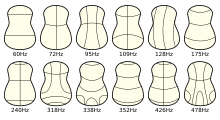Chladnian sound figure
Chladnian sound figures are patterns that arise on a thin plate (preferably made of metal ) sprinkled with sand when it is set in vibration . This is done by brushing the plate on one edge with a violin bow or touching a vibrating tuning fork .
As a result of natural resonance , the plate begins to vibrate with one of its modes . The sand is literally thrown away by the vibrating parts when the plate is tinted and moves to the places where no or weaker vibration occurs. In this way, the nodal lines of standing waves that form on the plate become visible.
Namesake
Chladnian sound figures are named after Ernst Florens Friedrich Chladni , who in 1787 published the book Discoveries on the theory of sound , in which he depicts sound figures and describes how they can be produced.
People were so fascinated by the patterns that Chladni was able to earn his living by acting as a teacher and speaker about his characters and even Napoleon said: "This man lets the tones see."
history
After Chladni made the sound figures known while traveling around Europe around 1800, mathematicians described the vibrations of elastic thin plates. It began between 1811 and 1815 by Sophie Germain with incorrect boundary conditions . Charles Wheatstone in 1833, Gustav Kirchhoff in 1850, Woldemar Voigt in 1893, Lord Rayleigh in 1894, Walter Ritz in 1909 took part in developing a theory .
Tonograph
Building on these findings, the American scholar Henry Holbrook Curtis constructed the tonograph with which these sound patterns could be recorded photographically . The apparatus consisted of a metal tube that was bent upwards like a horn and carried a bell at the top , on which a membrane was stretched. A fine mixture of salt and emery was applied to this and spread out evenly in the size of a piece of crown. When sounds were sung into the tube, the powdery mixture formed the chladnian figures, which were captured using photographic technology.
In a broadcast from the J. Fischer patent office in Vienna in 1897, it was stated: "The images can serve as models for singing exercises which the student who sings in a similarly designed apparatus must strive to achieve by bringing the same tone."
application
In the musical instrument is separated resorted to this method. For example, the guitar or violin top is excited by a loudspeaker that is connected to a frequency generator . The plate must swing freely. In order to later achieve an optimal vibration behavior of the ceiling, the mode (shape of the sand structure), which is assigned to the respective frequency , must be achieved as far as possible (see figure).
| Chladnian sound figure |
|---|
   
|
   
|
   
|
   
|
   
|
   
|
Mathematical model
Vibrating plates can be described according to Kirchhoff's plate theory with a biharmonic oscillation equation. In contrast to the d'Alembert operator, the Laplace operator is used twice. The natural vibrations or modes of the plate can be calculated by reducing the time.
The following shows the partial differential equation of free oscillation , i.e. without excitation:
Here is
- the material density
- the thickness of the plate
- the flexural strength of the plate.
Since this differential equation is not yet sufficient in relation to a physical solution, the boundary conditions must be chosen correctly.
Sophie Germain had also presented an equation of this form, but failed to establish the right boundary conditions.
Literature on theory
- Martin Gander, Gerhard Wanner: From Euler, Ritz and Galerkin to modern computing . SIAM Review, Vol 54 (4), 2012
- Karl-Eugen Kurrer : The History of the Theory of Structures. Searching for Equilibrium . Berlin: Ernst & Sohn 2018, pp. 703ff., ISBN 978-3-433-03229-9 .
Web links
- From Euler, Ritz, and Galerkinto Modern Computing
- Sounds for the eye ...? or the sound figures of the EFF Chladni
- Chladni Figures and Vibrating Plates - engl. - Java applet
- Natural vibration forms of round plates
- Larger pictures of sound figures and experimental setup from Ulm University
- Contribution to the experiments on the sound figures of a vibrating surface.
- LEIFI - Chladnian sound figures ( Memento from July 10, 2013 in the Internet Archive )
- Discoveries on The Theory of Sound , MPIWG Library Collection






